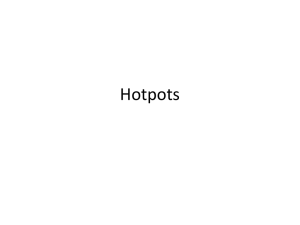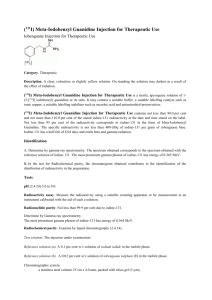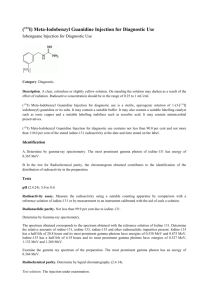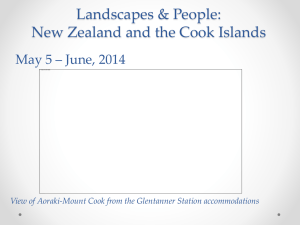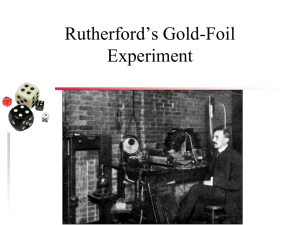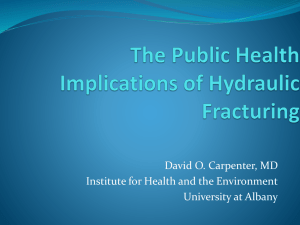Annual Report 2011
advertisement
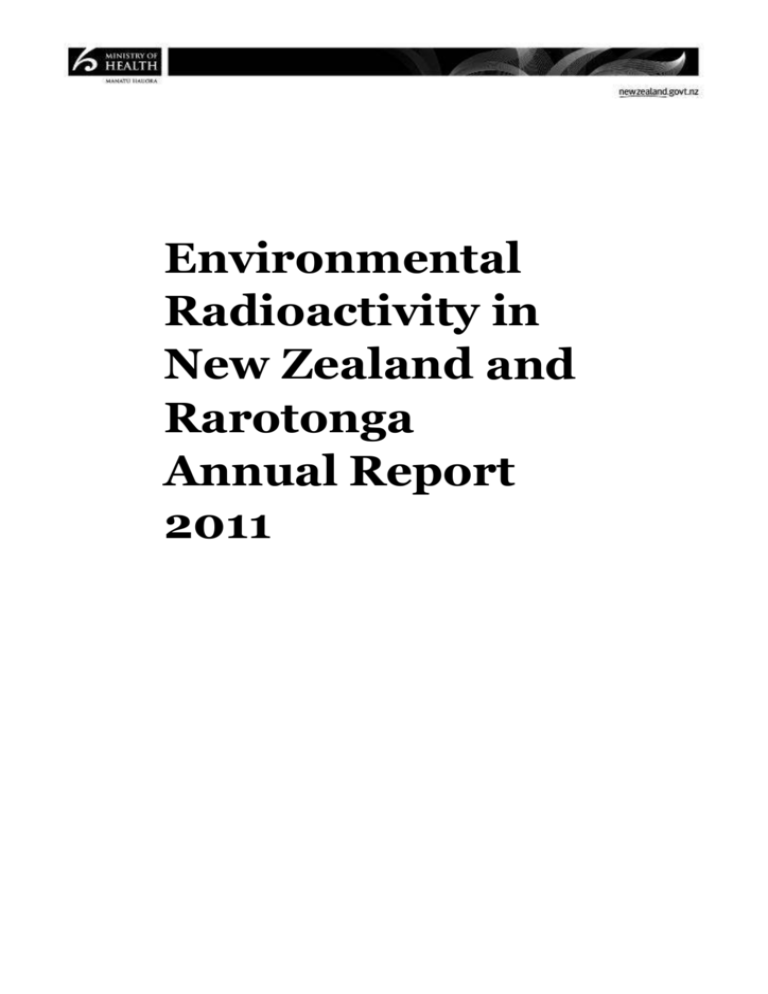
Environmental Radioactivity in New Zealand and Rarotonga Annual Report 2011 Citation: Ministry of Health. 2013. Environmental Radioactivity in New Zealand and Rarotonga: Annual Report 2011. Wellington: Ministry of Health. Published in May 2013 by the Ministry of Health PO Box 5013, Wellington 6145, New Zealand ISBN 978-0-478-40212-4 (online) HP 5585 This document is available at www.health.govt.nz This work is licensed under the Creative Commons Attribution 4.0 International licence. In essence, you are free to: share ie, copy and redistribute the material in any medium or format; adapt ie, remix, transform and build upon the material. You must give appropriate credit, provide a link to the licence and indicate if changes were made. Acknowledgements The Ministry of Health gratefully acknowledges Nikolaus Hermanspahn for his work in developing this report and the assistance of Mr Bruce Buckby of North Weather Ltd, Kaitaia; Mr Mark Crompton of West Weather Ltd, Hokitika; the Rarotonga Meteorological Service, in particular, Mr Roro Taia; and Mr Ross Morrison of Roskat Enterprises Ltd, Chatham Islands. The Managers of the Fonterra Te Rapa, Fonterra Whareroa and Westland Co-operative Dairy Co. (Hokitika) plants are also thanked for their assistance with the milk monitoring programme. The Environmental Laboratory of NRL organised the monitoring and analysed the samples. Disclaimer The purpose of this publication is to inform discussion and assist policy development. The opinions expressed in the publication do not necessarily reflect the official views of the Ministry of Health. The Ministry of Health makes no warranty, expressed or implied, nor assumes any legal liability or responsibility for the accuracy, correctness, completeness or use of the information or data in this publication. Further, the Ministry of Health shall not be liable for any loss or damage arising directly or indirectly from the information or data presented in this publication. The Ministry of Health welcomes comments and suggestions about this publication. Environmental Radioactivity in New Zealand and Rarotonga: Annual Report 2011 iii Contents Acknowledgements iii Summary 1 Introduction 2 2011 monitoring programme 5 2011 monitoring results 6 Atmospheric radioactivity 6 Radioactive deposition 6 Radioactivity in milk 7 Discussion 7 Quality management 8 List of tables Table 1: Table 2: iv The annual average concentrations of 7Be and 210Pb in air filters in 2011 at three monitoring stations 6 Annual average 137Cs concentrations in monthly milk powder samples from Waikato, Taranaki and Westland for 2011 7 Environmental Radioactivity in New Zealand and Rarotonga: Annual Report 2011 Summary The atmosphere was monitored for radioactivity at Kaitaia, the Chatham Islands and Rarotonga; deposited radioactivity was monitored at Hokitika (through rainwater testing); and radioactivity in milk was monitored in the Waikato, Taranaki and Westland regions. Any artificial radioactivity continued to be at levels that are below detection thresholds in many cases and significantly below levels that would give rise to health concerns. In particular, no radioactive contamination from the Fukushima Daiichi nuclear accident was observed in the New Zealand environment. No significant change in the radioactivity status of the environment occurred in 2011. Environmental Radioactivity in New Zealand and Rarotonga: Annual Report 2011 1 Introduction The National Radiation Laboratory (NRL) has monitored environmental radioactivity levels in the New Zealand and South Pacific regions since 1960, as described in earlier reports in this series.1,2 Monitoring was initially conducted for radioactive fallout from nuclear weapons tests in the northern hemisphere and then for fallout from the French nuclear weapons testing programme in the Tuamotu Archipelago. When the French atmospheric radiation testing programme was terminated in 1974, monitoring continued for residues from atmospheric tests and to detect any venting from the underground tests. By 1985, levels of weapons-test debris in the atmosphere and rainwater had decreased to near the limits of detection for the monitoring techniques in use at the time, and the extensive monitoring network was scaled down3 to three monitoring sites – two in New Zealand (Kaitaia and Hokitika) and one in the Cook Islands (Rarotonga). The sensitivity of weekly atmospheric monitoring at these sites was increased with the installation of 150 m3/hour high volume air samplers.4 5 Following the signing of the Comprehensive Nuclear-Test-Ban Treaty (CTBT) by the United Nations member countries in September 1996, verification of treaty compliance became an important international issue. New Zealand signed the CTBT on 27 September 1996, and ratified the CTBT on 19 March 1999, with the passing of the Nuclear-Test-Ban Act. To enforce the CTBT, the International Monitoring System was designed to provide, on a global scale, passive monitoring capable of detecting and locating nuclear explosions. The four monitoring techniques are seismic, radionuclide, infrasound and hydro-acoustic. The planned radionuclide monitoring network will consist of 80 Environmental Radioactivity Annual Reports: NRL-F/48 (1971)–NRL-F/52 (1973) summarising previous results, NRL-F/54 (1974)–NRL-F/75 (1995). National Radiation Laboratory, Christchurch. 1 Environmental Radioactivity: Fallout from nuclear weapons tests conducted by France in the South Pacific and comparisons with previous test series. Reports: NRL-F/47 (1971), summarising all monitoring since 1966; NRL-F/49 (1972); NRL-F/51 (1973); NRL-F/53 (1974). National Radiation Laboratory, Christchurch. 2 National Radiation Laboratory. 1985. Environmental Radioactivity Annual Report 1984. Christchurch: National Radiation Laboratory. 3 National Radiation Laboratory. 1986. Environmental Radioactivity Annual Report 1985. Christchurch: National Radiation Laboratory. 4 Comprehensive Nuclear-Test-Ban Treaty (CTBT) and Text on the Establishment of a Preparatory Commission for the Comprehensive Nuclear-Test-Ban Treaty Organization. Preparatory Commission for the Comprehensive Nuclear-Test-Ban Treaty, Vienna, 1996. 5 2 Environmental Radioactivity in New Zealand and Rarotonga: Annual Report 2011 particulate radionuclide stations. These stations are to be distributed over 39 countries and their territories. As of mid-2010, more than 60 radionuclide stations had been installed. These include stations located at Kaitaia and the Chatham Islands, New Zealand and Rarotonga, Cook Islands. In 2000, and in accordance with the CTBT, the monitoring stations at Kaitaia and Rarotonga were upgraded and a new station was commissioned in the Chatham Islands. These stations are now capable of daily monitoring with a greater sensitivity 3 resulting from the installation of 900 m /hour high-volume air samplers. In conjunction with radionuclide detection, meteorological “back-tracking” provides information on any radionuclide source location through analysis of wind patterns in the preceding days and weeks of measurement. Meteorological stations operating to World Meteorological Organization standards are located at each site. The present monitoring programme, consisting of wet and dry deposition radioactivity monitoring and the monitoring of radioactivity in milk, is intended to warn of any influx of radioactivity into the New Zealand and South Pacific regions from any source and to monitor trends in levels. The monitoring programme provides the basis for certification of the radioactivity content of foodstuffs. It also serves as the basis of consumer and commercial advisory services concerning radioactivity and for comparisons of the environmental radioactivity status of the South Pacific region with that of other regions. To maintain a high standard of capability in radiochemical analysis, NRL takes part in quality assurance programmes and international analytical intercomparison exercises run by the IAEA, the Comprehensive Nuclear-Test-Ban Treaty Organization (CTBTO), the National Physical Laboratory (UK) and the United States Department of Energy. Although the environmental monitoring programme is designed primarily to detect and monitor levels of artificial radioactivity, measurements include naturally occurring radioactive materials, for comparative and scientific purposes. The atmospheric monitoring therefore includes measurements of concentrations of beryllium-7 (7Be) and lead-210 (210Pb) in the atmosphere. 7Be is a cosmogenic nuclide (a product of spallation reactions of cosmic radiation within the upper atmosphere), while 210Pb is a decay product of gaseous radon-222, which diffuses out of soil. The 1993 report6 provided full discussion of trends in atmospheric caesium-137 (137Cs) levels, radionuclides that contribute to the measured atmospheric beta activity, the age of aerosols collected in the NRL monitoring network, current concentrations of 137Cs in New Zealand soils and dietary radiation exposure due to fallout (both natural and artificial). National Radiation Laboratory. 1994. Environmental Radioactivity Annual Report 1993. Christchurch: National Radiation Laboratory. 6 Environmental Radioactivity in New Zealand and Rarotonga: Annual Report 2011 3 In 2004, NRL stopped monitoring levels of strontium-90 (90Sr) in milk powders because the concentrations had fallen below the detection limit and were far below the reference level of 120 Bq/kg. The present fallout monitoring programme will detect any 90 new deposition of Sr. 4 Environmental Radioactivity in New Zealand and Rarotonga: Annual Report 2011 2011 monitoring programme The environmental radioactivity monitoring programme comprised the following elements during 2011. Atmospheric radioactivity: Atmospheric monitoring is the most important component of the monitoring programme because any radioactive pollution reaching the region will have been transported in the atmosphere, and the high-sensitivity monitoring will provide an early warning of any influx or changing trend in environmental radioactivity levels. Particulates were collected daily from the Kaitaia, Chatham Islands and Rarotonga stations. The stations at Kaitaia, the Chatham Islands and Rarotonga used a SENYA “Snow White” air sampler to draw air through 2025 cm2 filters (3M filter, polypropylene BMF) at a flow rate of approximately 900 m3/hour, with a daily sample volume of approximately 20,000 m3. The filters were analysed by high-resolution gamma spectrometry (Canberra high-purity n-type germanium BEGE5030 detector) for gamma-emitting artificial and natural radionuclides. The minimum detectable 137 concentration for the fission product, Cs, in the daily filter analyses ranged from 1 to 5 Bq/m3. Radioactive deposition: The total beta-activity concentration in the deposition was 2 monitored at Hokitika with weekly (small area rain collector 0.021 m ) sample collection. The total beta concentration was determined at NRL using a liquid scintillation counter. The large-area rain collector at Hokitika allowed the monitoring of weekly depositions of the artificial radionuclides in rainwater. A stainless steel rain collector (1 m2) had an ion exchange resin column attached to its base. The resin retains any cationic species present in the rainwater, which percolates through it. The column remained attached to the collector for the 1-week sampling period, after which it was returned to NRL for gamma spectrometric analysis. 7Be measurements were used as a quality control for the performance of the sampling system. 131 134 137 Radioactivity in milk: Iodine-131 ( I), caesium-134 ( Cs) and Cs concentrations were monitored in monthly samples of dairy milk powders by gamma spectrometry from three New Zealand regions – Waikato, Taranaki and Westland. Environmental Radioactivity in New Zealand and Rarotonga: Annual Report 2011 5 2011 monitoring results Radioactivity units used throughout this report are becquerels (Bq), millibecquerels (mBq) and microbecquerels (µBq): 1 Bq = 1 nuclear transformation per second. The uncertainties reported are standard deviations of the mean values multiplied by a coverage factor (k) = 2, providing a level of confidence of 95%. Atmospheric radioactivity No significant concentrations of artificial radionuclides were detected by gammaspectroscopic analysis of air filters collected daily from each monitoring station during 2011. 7Be continued to be the most significant radionuclide detected on the air filters during 2011. 210Pb levels were similar at all three monitoring sites. The annual average concentrations of 7Be and 210Pb on the air filters from Kaitaia, the Chatham Islands and Rarotonga are presented in Table 1. Table 1: The annual average concentrations of 7Be and 210Pb in air filters in 2011 at three monitoring stations Sampling site 7Be (Bq/m3) 210Pb (Bq/m3) Kaitaia 3630 ± 41 99 ± 10 Chatham Islands 3485 ± 46 69 ± 10 Rarotonga 3892 ± 41 89.1 ± 7.5 Neither 131 I nor any other fission products were detected at these stations. Typical detection limits were in 3 the range of 1 to 5 Bq/m for 131 134 I, Cs and 137 Cs. Radioactive deposition The Christchurch earthquake 22 February 2011 disrupted the operation of the NRL environmental laboratory. This disruption was managed by extending the sampling period of the large area collector until the laboratory was capable of receiving samples again. The weekly rainwater sampling continued as per schedule. Samples were stored in Hokitika until NRL was ready to accept them. No artificial radionuclides were detected in the deposition samples by gammaspectrometric analysis. The deposition of beta emitters for 2011 at Hokitika was 485 ± 20 Bq/m2 with 2600 mm of rainfall. The average weekly deposition was 9.9 ± 2.3 Bq/m2. 6 Environmental Radioactivity in New Zealand and Rarotonga: Annual Report 2011 Radioactivity in milk The radioactivity content of cows’ milk was assessed by gamma spectrometric analysis 137 of monthly milk samples from three regions – Waikato, Taranaki and Westland. Cs was the only detectable artificial radionuclide. Results are summarised in Table 2. 137 Table 2: Annual average Cs concentrations in monthly milk powder samples from Waikato, Taranaki and Westland for 2011 Region 137 Cs (Bq/kg) Waikato 0.47 ± 0.19 Taranaki 0.72 ± 0.37 Westland 0.33 ± 0.14 Discussion Despite interruption to NRL’s operations in Christchurch in early 2011, the monitoring programme was continued without any significant disruption. Neither deposition nor air monitoring showed any signs of influx of radioactive contamination. Caesium-137 continues to be the only fission product detectable in milk, and levels continue to decrease consistent with observations from the last decade. No significant change in the radioactivity status of the environment occurred in 2011. Environmental Radioactivity in New Zealand and Rarotonga: Annual Report 2011 7 Quality management Quality management is an essential feature of any measurement laboratory’s operations. In May 2011, the Environmental Laboratory’s accreditation to the international standard NZS/ISO/IEC17025 “General requirements for the competence of testing and calibration laboratories” was reassessed and confirmed. The scope of accreditation includes environmental monitoring and the analyses of foodstuffs and waters. During 2011, the Environmental Laboratory participated in five intercomparison exercises, conducted by the International Atomic Energy Agency, the British National Physical Laboratory, the Comprehensive Nuclear-Test-Ban Treaty Organization and the US Department of Energy. These exercises involved the analyses of air filters, soil, vegetation and water. Environmental Radioactivity in New Zealand and Rarotonga: Annual Report 2011 8

